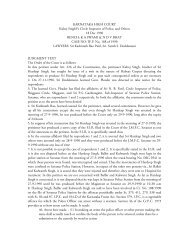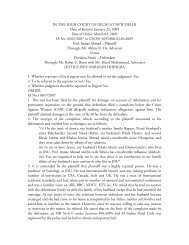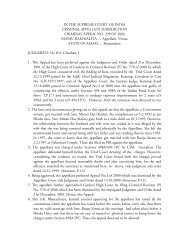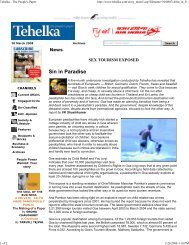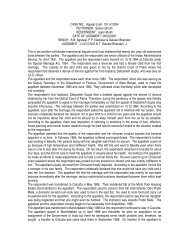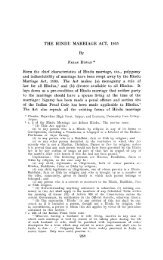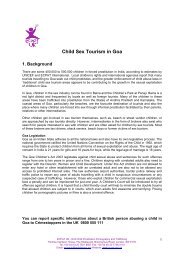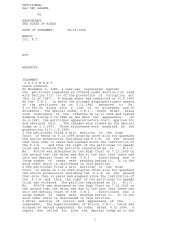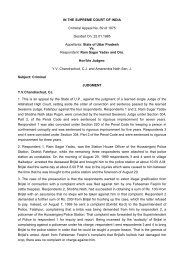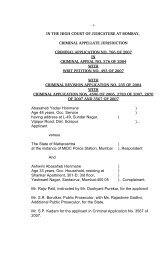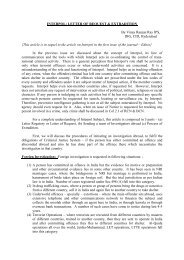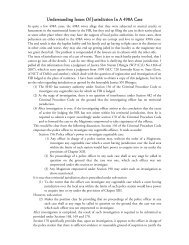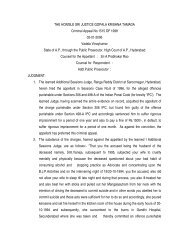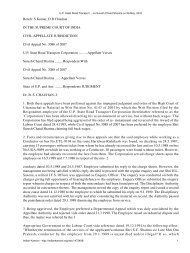Afaf Nassar Khalifa Vs Michael Shannon - IPC 498A
Afaf Nassar Khalifa Vs Michael Shannon - IPC 498A
Afaf Nassar Khalifa Vs Michael Shannon - IPC 498A
You also want an ePaper? Increase the reach of your titles
YUMPU automatically turns print PDFs into web optimized ePapers that Google loves.
IN THE COURT OF APPEALSOF MARYLANDNo. 56September Term, 2007AFAF NASSAR KHALIFA, ET AL.v.MICHAEL SHANNONBell, C.J.RakerHarrellBattagliaGreeneWilner, Alan M. (Retired,specially assigned)Cathell, Dale R. (Retired,specially assigned),JJ.Opinion by Battaglia, J.Raker, J., Concurs.Filed: April 9, 2008
The issue in this case is whether a cause of action for intentional interference withcustody and visitation rights is sustainable by a father, <strong>Michael</strong> <strong>Shannon</strong>, against his formerwife, Nermeen <strong>Khalifa</strong> <strong>Shannon</strong>, and her mother, <strong>Afaf</strong> <strong>Nassar</strong> <strong>Khalifa</strong> (“Appellants”), bothof whom fled to Egypt with the couple’s two minor children, who remain there. Appellantsmoved to dismiss the father’s complaint, arguing that interference with custody andvisitation rights is not a cognizable cause of action in Maryland, and alternatively, that evenif Maryland recognizes the tort, the Complaint fails to allege a loss of the children’s services,which is a required element. The trial court disagreed, and after a trial, the jury awarded$3,017,500 in compensatory and punitive damages. Appellants noted an appeal to the Courtof Special Appeals, and prior to any proceedings in that court, we issued a writ of certiorarion our own initiative, <strong>Khalifa</strong> v. <strong>Shannon</strong>, 400 Md. 647, 929 A.2d 889 (2007), to address thefollowing issues:I. Did the trial court commit reversible error when it denied thedefendant-appellants’ motion to dismiss Count One of theComplaint by recognizing the tort of interference with custodyand visitation rights of children?II. Did the trial court commit reversible error when it denied thedefendant-appellants’ motion to dismiss Count Two of theComplaint by recognizing the tort of civil conspiracy? [1]III. Did the trial court commit reversible error when it deniedthe defendant-appellants’ motion for a new trial, and/or forremittur, because the punitive damages awarded by the jurywere grossly excessive and there was no evidence on the record1Because we hold that the tort of interference with custody and visitations rightsis recognized in Maryland, we need not reach the second question. A recent case, Lloyd v.General Motors Corp., 397 Md. 108, 154, 916 A.2d 257, 284 (2007), discussed the elementsof the tort of civil conspiracy.
of defendant-appellants’ ability to pay?We shall hold that the trial court did not err in denying Appellants’ motion to dismissCount I relating to interference with custody and visitation rights because we have heretoforerecognized the tort without requiring the loss of services of the child to be pled. We alsoshall hold that the trial court did not err when denying Appellants’ post-trial motionsregarding damages.I. Facts<strong>Michael</strong> <strong>Shannon</strong> initiated the instant civil suit against his ex-wife, Nermeen <strong>Khalifa</strong><strong>Shannon</strong>, her mother, <strong>Afaf</strong> <strong>Nassar</strong> <strong>Khalifa</strong>, her father, Mohammed Osama <strong>Khalifa</strong>, and herolder sister, Dahlia <strong>Khalifa</strong>, in March of 2004. The Complaint contained four counts: CountI, Interference with Custody and Visitation Rights of Children; Count II, Civil Conspiracy;Count III, Loss of Society of Children; and Count IV, False Imprisonment, with thefollowing factual allegations:8. Mr. <strong>Shannon</strong> married Defendant Nermeen <strong>Khalifa</strong> <strong>Shannon</strong>on March 3, 1996.9. Adam Osama <strong>Shannon</strong> was born on February 9, 1997.10. Jason Osama Kalifa [sic] was born on January 10, 2001.11. Mr. <strong>Shannon</strong> and defendant Nermmen <strong>Khalifa</strong> <strong>Shannon</strong>separated in January 2000.12. In February 2001 this Court entered a consent order thatgranted Mr. <strong>Shannon</strong> custody of Adam; and Nermeen custodyof Jason.2
13. Each parent also had visitation rights with their noncustodialchild.14. On August 18, 2001, Defendant <strong>Afaf</strong> <strong>Nassar</strong> <strong>Khalifa</strong> flewto Washington, D.C. from Egypt and stayed with Nermeen<strong>Shannon</strong> in her apartment.15. Mr. <strong>Shannon</strong> agreed that both boys could visit a cousin inBrooklyn, New York with Defendants, Nermeen <strong>Khalifa</strong><strong>Shannon</strong> and <strong>Afaf</strong> <strong>Nassar</strong> <strong>Khalifa</strong>, as long as the boys werereturned to him by Sunday night, August 26, 2001.16. The boys were not returned to Maryland.17. The Defendants had previously and calculatedly arrangedto put the boys on an airplane to Egypt.18. The Defendants did put the boys on an airplane to Egyptand Mr. <strong>Shannon</strong> has not seen his American sons since August2001.19. Defendant, <strong>Afaf</strong> <strong>Nassar</strong> <strong>Khalifa</strong> was extradited toMaryland.20. Defendant, <strong>Afaf</strong> <strong>Nassar</strong> <strong>Khalifa</strong> was sentenced to a ten yearprison term. That sentence was later revised to a three yearsentence.21. The abductions and kidnapping [sic] of the children are ongoing.* * *23. At the time of the abductions. Mr. <strong>Shannon</strong> was legallyentitled to custody of Adam and visitation with Jason.24. The Defendants intentionally interfered, and continue tointerfere with Mr. <strong>Shannon</strong>’s custody and custody [sic] andvisitations rights by abducting the children to Egypt andrefusing to return them.3
25. The Defendants intentionally interfered, and continue tointerfere with Mr. <strong>Shannon</strong>’s custody and visitation rights byknowingly and intentionally refusing to allow Mr. <strong>Shannon</strong> tosee or communicate in any manner with his sons.26. As a result of the Defendants’ ongoing and continuingintentional interference with Mr. <strong>Shannon</strong>’s custody andvisitation rights, Mr. <strong>Shannon</strong> has suffered damages.<strong>Afaf</strong> <strong>Nassar</strong> <strong>Khalifa</strong> was served with the Complaint and a writ of summons whileserving a three-year sentence, after she had been convicted of conspiracy and abductionunder Section 9-305 (1984, 1999 Repl. Vol.), and amended Section 9-305 (1984, 1999 Repl.Vol., 2002 Supp.) of the Family Law Article. 2 Her attorney moved to dismiss the Complaintfor lack of personal jurisdiction and insufficiency of service of process, which the courtdenied.After numerous attempts to serve Nermeen <strong>Khalifa</strong> <strong>Shannon</strong>, the court orderedalternate service by mail and by publication in The Cairo Times. Nermeen <strong>Khalifa</strong>, throughthe same attorney, subsequently moved to dismiss for lack of personal jurisdiction,insufficiency of service of process, lack of subject matter jurisdiction, and failure to state aclaim upon which relief can be granted, which the trial court denied. 3The complaintsagainst the father-in-law and sister-in-law were later dismissed.2(2004).We affirmed her conviction in <strong>Khalifa</strong> v. State, 382 Md. 400, 855 A.2d 11753We note that no Answer was ever filed, and no default judgment was everrequested or entered. Appellants, however, have not been adversely affected by their failureto file an Answer because the case was tried on the merits.4
The case went to trial in December of 2006. At the close of argument, the courtdismissed the false imprisonment and loss of society counts. After deliberating over theremaining counts of interference with custody and visitation rights and civil conspiracy andcompleting a special verdict form, the jury awarded <strong>Shannon</strong> $17,500 in attorney fees andcosts; $500,000 in compensatory damages against each defendant; $900,000 in punitivedamages against <strong>Afaf</strong> <strong>Nassar</strong> <strong>Khalifa</strong> and $1,100,000 million in punitive damages againstNermeen <strong>Khalifa</strong> <strong>Shannon</strong>. Appellants moved for a judgment notwithstanding the verdict,a new trial, and for remittur, arguing grossly excessive damages, all of which the CircuitCourt denied. Appellants noted their appeal to the Court of the Special Appeals, and weissued a writ of certiorari prior to any proceedings in the intermediate appellate court.<strong>Khalifa</strong>, 400 Md. at 647, 929 A.2d at 889.II. BackgroundAppellants contend that the Circuit Court erred when it denied their Motion toDismiss the Complaint for failure to state a claim upon which relief can be granted, becauseMaryland does not recognize the tort of interference with custody and visitation. Appellantsalternatively posit that if Maryland recognizes the tort of interference with custody andvisitation, the lower court erred when it refused to dismiss the complaint for failure to statea claim because a parent must plead and prove a child’s services to maintain the cause ofaction, which did not occur in the present case, and also contend that if this Court accepts5
citing Morris v. Osmose Wood Preserving, 340 Md. 519, 531, 667 A.2d 624, 631 (1995);Faya v. Almaraz, 329 Md. 435, 443, 620 A.2d 327, 331 (1993). “Moreover, in determiningwhether a petitioner has alleged claims upon which relief can be granted, ‘[t]here is . . . a bigdifference between that which is necessary to prove the [commission of a tort] and thatwhich is necessary merely to allege [its commission],’ and, when that is the issue, the court’sdecision does not pass on the merits of the claims; it merely determines the plaintiff’s rightto bring the action.” Lloyd, 397 Md. at 121-22, 916 A.2d at 265 (alterations in original),quoting Sharrow, 306 Md. at 770, 511 A.2d at 500. “Furthermore, the court must view allwell-pleaded facts and the inferences from those facts in a light most favorable to theplaintiff.” Id. at 122, 916 A.2d at 265, citing Board of Education v. Browning, 333 Md. 281,286, 635 A.2d 373, 376 (1994).This Court apparently first explicitly recognized the torts of abduction of a child froma parent and harboring in Baumgartner v. Eigenbrot, 100 Md. 508, 60 A. 601 (1905). InBaumgartner, an aunt, who had legal guardianship over a teenage girl, sued a husband andwife with whom the girl had chosen to live, alleging that they had abducted the child andharbored her after she had been so abducted. The complaint specifically alleged thatdefendants abducted and knowingly deprived the aunt of the young woman, that the aunt“became greatly attached to her,” and that the aunt “derived great comfort from [the child’s]society as she grew to be larger,” thereby incurring non-economic losses. Id. at 509, 60 A.at 601. The trial judge had directed a verdict because of insufficiency of the evidence, and8
we affirmed, opining that the evidence was not sufficient to meet the elements of abductionand harboring, which we declared were tortious acts:“Abduction, in its broadest legal sense, signifies the act oftaking and carrying away by force, which may be by fraud,persuasion, or open violence, a child, ward, wife, etc. In itsmore restricted sense it is confined to the taking of females forthe purpose of marriage, concubinage, or prostitution.”Id. at 513, 60 A. at 603, quoting 1 Encyclopedia of Law and Procedure 141 (1901), as wellas:“Abduction is the unlawful taking or detention by force, fraud,or persuasion of a person, as a wife, a child or a ward, from thepossession, custody, or control of the person legally entitledthereto.”Id., quoting 1 American and English Encyclopedia of Law 163 (2d ed. 1896), and finally: 6“In the law of torts, to harbor is to receive, clandestinely orwithout [legal] authority, a person for the purpose of soconcealing him, that another having the right to the [legal]6The American and English Encyclopedia of Law, in the section subsequent tothat cited by the court in Baumgartner, included the following:IV. ABDUCTION OF CHILD–1. Rights of Parents–GeneralRule.– A father has a right of actions against every person whoknowingly and wittingly interrupts the relation subsistingbetween himself and his child by enticing or abducting suchchild away from him, or by harboring the child after he has leftthe father’s house.* * *2. Gist of the Action–The gist of the action for the abduction ofa child would seem to be not the loss of service, but the loss tothe parent of the comfort and society of the child, though theauthorities are not in harmony upon the question.9
custody of such persons shall be deprived thereof; . . . or, in aless technical sense, it is a reception of persons improperly.”Id. (alteration in original), quoting 15 American and English Encyclopedia of Law 285 (2ded. 1900). After iterating the rule for abduction, we determined that the evidence wasinsufficient to meet the elements of abduction and harboring:Id. at 516, 60 A. at 604.Now, in all this there is not an element of abduction as it hasbeen defined in the authorities cited in an earlier part of thisopinion. Confessedly there was no force used. There was nofraud. There was no open violence and there is no evidence toindicate that there was persuasion of any kind. It would begoing a long distance beyond what any case has held to say thatthe facts we have heretofore given in detail fasten upon thedefendants or either of them the charge of abduction. And as tothe second count of the declaration there is not any evidencewhatever to show that Matilda was received clandestinely forthe purpose of concealing her from the plaintiff nor is thereanything to indicate that her reception by the defendants was inany sense improper.We conclude, then, from this review of the evidence in therecord that the court below was entirely right in declining topermit this case to go to the jury. As we find no error in any ofits rulings the judgment which was rendered in favor of thedefendants will be affirmed with costs.By doing so, we held that a cause of action was viable against one who abducted achild from a custodian and harbored her. Clearly, the definitions of the torts and ouracknowledgment of their existence were “pivotal” and necessary premises upon which ourultimate conclusion was based, and thus, were holdings in the case. See Black’s LawDictionary 749 (8th ed. 2004) (A holding is a “court’s determination of a matter of law10
pivotal to its decision” or a “ruling on evidence or other question presented at trial.”). Seealso Howell v. Howell, 78 S. E. 222, 224 (N.C. 1913) (Baumgartner “held that if the childwas kept in defendant’s custody in a clandestine manner an action would lie”).Our acknowledgment of the torts of abduction and of harboring in Baumgartner,furthermore, was consistent with substantial authority from many of our sister states, whoalso were original American colonies, facing the same question. In what appears to be theearliest known and most frequently cited American case on abduction, the South CarolinaCourt of Law in Kirkpatrick v. Lockhart, 4 S.C.L. (2 Brev.) 276 (1809), although primarilyconcerned with whether it was appropriate to plead abduction in trespass vi et armis or intrespass on the case, relied primarily on the English case, decided in 1600, Barham v.Dennis, 78 Eng. Rep. 1001, and held that a father could sustain an abduction action not onlyfor his son and heir, but for the abduction of any one of his children:It has been decided, that a father may maintain an action oftrespass vi et armis, for entering his house, assaulting hisdaughter, and getting her with child, per quod, 3 Wils. 18. So,an action on the case lies for debauching his daughter, per quodservitium amisit, though she be above the age of twenty-oneyears, where acts of service are proved. 2 D. and E. 166 and seq.It was always held to lie where the daughter is undertwenty-one, though no acts of service are proved, 2 D. and E. 4,5; and other evidence, besides what applies to loss of service, isadmissible. 3 Esp. R. 119. 8 D. and E. 534. I mention thesecases, to exhibit the true foundation of these kinds of actions .. . .* * *The true ground of action cannot be the loss of service, for a11
child may be of an age so tender, or of a constitution so delicate,as to be incapable of rendering any service. The true ground ofaction is the outrage, and deprivation; the injury the fathersustains in the loss of his child . . . .Years later, in Howell, 78 S.E. at 222, the Supreme Court of North Carolina, whenpresented with facts remarkably similar to the instant case, also recognized the tort ofabduction. In Howell, a father and mother entered into a contract prior to divorce, underwhich their daughter would remain in the mother’s custody until the age of six, at which timethe father would become the custodian. Shortly before the child attained the age of six, themother and her partner abducted the child, and the father sued for damages. In reversing thetrial court’s dismissal for failure to state a claim, the Supreme Court of North Carolinadiscussed at considerable length the history of the tort of abduction in English common law,including Barham, and held that the torts of abduction and harboring were recognized andthat a father could bring the cause of action for any of his children:At the common law, abduction of a child was not an offense.State v. Rice, 76 N. C. 194. But Blackstone, 3 Com. 140, holdsthat a civil action lay therefor, and that a father could recoverdamages, though he says it was a doubtful question, on whichthe authorities were divided, whether a father could recover forthe abduction of any other child than the oldest son and heir. InBarham v. Dennis, Cro. Eliz. 770, it was held that he could not.But later cases held that an action would lie for taking away anyof the children because the parent “had an interest in them all.”It is interesting to quote the reasoning of the courts at commonlaw as given in Barham v. Dennis, supra. Anderson, Walmsley,and Kingsmil, JJ., said: “The father should not have an actionfor the taking of any of his children, which is not his heir; andthat is by reason the marriage of his heir belongs to the father,but not of any other his sons or daughters; and by reason of this12
loss only, the action is given unto him; the writ in the Registeris for the son and heir, or daughter and heir only; which provesthat the law has always been taken, that the action lies not forany other son or daughter. And although it hath been said thata writ of trespass lies for divers things whereof none of them arein the Register; and it hath been adjudged that it lies for a parrot,a popinjay, a thrush, and as in 14 Henry VIII for a dog; thereason thereof is, because the law imputes that the owner hatha property in them. . . . But for the taking of a son or daughternot heir, it is not upon the same reason, and therefore not alike.Here the father hath not any property or interest in the daughterwhich the law accounts may be taken from him.” Glanville, J.,dissenting, said: “The father hath an interest in every of hischildren to educate them, and to provide for them, and he hathhis comfort by them; wherefore it is not reasonable that anyshould take them from him, and to do him such an injury, butthat he should have his remedy to punish it.” The majority ofthe court are sustained by the form of the writ as preserved inFitz-Herbert’s Natura Brevium 90 H., which was of date 12Hen. IV, 16. But Judge Glanville based his dissent upon reasonand justice and has been sustained by subsequent cases.Id. at 223-24 (ellipsis in original).Similarly, the Court of Appeals of New York conducted an extensive analysis ofAmerican and English common law in Pickle v. Page, 169 N.E. 650, 651 (N.Y. 1930):An action of trespass for the abduction of a child was originallymaintainable by a father where the child abducted was the sonand heir and not otherwise. Barham v. Dennis, 2 Cro. Eliz. 770.This was “by reason the marriage of his heir belongs to thefather, but not of any other his sons or daughters;” and, althoughit had been adjudged that the writ of trespass lay “for a parrot,a popinjay, a thrush, and, as 14 Hen. 8 is, for a dog; the reasonthereof is, because the law imputes that the owner hath aproperty in them,” whereas “the father hath not any property orinterest in the daughter, which the law accounts may be takenfrom him.” Later it was held that an action of trespass wasmaintainable by a father per quod servitium amisit where a child13
old enough to do him service, other than the heir, was abducted.For the abduction of any other child the action did not lie. Grayv. Jefferies, 1 Cro. Eliz. 55; Hall v. Hollander, 4 Barn. & C.660. In the latter case it was said: “It is clear that in cases oftaking away a son or daughter, except for taking a son and heir,no action lies, unless a loss of service is sustained, Gray v.Jefferies, supra; Barham v. Dennis, supra. The mererelationship of the parties is not sufficient to constitute a loss ofservice.” In the case of an injury inflicted upon a child soimmature that it was incapable of rendering service, the parentmight have no remedy against the person inflicting the injury.Hall v. Hollander, supra.The principle that the abduction of a child, not the heir, or notcapable of rendering service, was a wrong for which the lawfurnished no civil remedy, was not adopted without protest, norhas it received unqualified approval. Thus in Barham v. Dennis,supra, Glanville uttered a strong dissent, saying: “For the fatherhath an interest in every of his children to educate them, and toprovide for them; and he hath his comfort by them; whereforeit is not reasonable that any should take them from him, and todo him such an injury, but that he should have his remedy topunish it.” Blackstone was of the opinion that for the abductionof a child, other than the heir, a father might maintain an action,stating that such a wrong was “remediable by writ of ravishmentor action of trespass vi et armis, de filio, vel filia, rapto velabducto; in the same manner as the husband may have it onaccount of the abduction of his wife.” Bl. Comm. 140.Based on this, the New York Court of Appeals concluded that the cause of action forabduction and harboring existed irrespective of loss of services:In the absence of any New York authority upon the subject [ofabduction and harboring] . . . we are disposed to hold broadly,as have courts of North and South Carolina, that in actions forthe abduction of immature children from the custody of theirlawful custodians, parents, or foster parents, no loss of serviceneed be alleged or proven; that for the direct injury done, adirect recovery may be had without resort to the fiction that a14
loss of service has been occasioned.Id. at 653.In a more recent case, Murphy v. I.S.K.Con. of New England, Inc., 571 N.E.2d 340(Mass. 1991), which cited the Restatement (Second) of Torts, Section 700, the SupremeJudicial Court of Massachusetts held that the torts of abduction, harboring and enticementalso were recognized causes of action under Massachusetts law and explained how thesecommon law torts formed the basis for the single contemporary tort of interference withparent-child relations: 7“The common law has traditionally recognized a parent’sinterest in freedom from tortious conduct harming hisrelationship with his child,” and the parent “may becompensated therefor when there is interference with the normalparent-child relationship.” The tortious conduct referred to [inprevious Massachusetts cases] includes the abduction,enticement, and harboring and secreting of minor children fromtheir parents, or in other words, the intentional interference withparental interests or rights. The elements of these causes ofaction are well established. Abduction is the physical taking ofa minor child from the parent having legal custody. An actionfor enticement will lie where one, through an “active andwrongful effort” and knowing that the parent does not consent,induces a child to leave the parent’s home. One “harbors” aminor child by inducing or encouraging a child, who is awayfrom the parent without the parent’s consent, to remain awayfrom the parent.* * *7We recognized the common law tort action of enticement in Kenney v.Baltimore and Ohio Railroad Co., 101 Md. 490, 61 A. 581 (1905), and Loomis v. Deets, 30A. 612 (Md. 1894).15
We therefore acknowledge the tort of intentional interferencewith the parent child relationship as a contemporary expressionencompassing actions for abduction, enticement, harboring, andsecreting of a minor child from the parent having legal custody.Id. at 351, 352 (citations omitted).In total, the torts of abduction and harboring have been recognized in at least eightof the other original American colonies. See, e.g., Selman v. Barnett, 61 S.E. 501, 502 (Ga.Ct. App. 1908) (holding that one standing in loco parentis can seek general and punitivedamages for the abduction and harboring of her child); Plante v. Engel, 469 A.2d 1299,1301-02 (N.H. 1983) (referencing the Restatement (Second) of Torts, Section 700 throughcommon law torts of abduction and harboring); Magee v. Holland, 27 N.J.L. 86 (N.J. Sup.Ct. 1858) (holding that a father could recover for the emotional harm caused by theabduction of his child); Moritz v. Garnhart, 7 Watts 302 (Pa. 1838) (holding that onestanding in loco parentis may maintain an action for the abduction of his daughter’sillegitimate offspring). What we glean from these cases, and in particular those casesdiscussing the English common law, is that the torts of abduction and harboring existed inEngland prior to 1776, and that, therefore, we adopted them as part of our common lawunder Article V of the Maryland Declaration of Rights, which states in pertinent part that“the Inhabitants of Maryland are entitled to the Common Law of England . . . according tothe course of that Law, and to the benefit of the English statutes as existed on the Fourth dayof July, seventeen hundred and seventy-six.”Nevertheless, this Court was not called upon to address whether abduction and16
harboring could be the basis of a cause of action for interference with parent-child relationsuntil Hixon v. Buchberger, 306 Md. 72, 507 A.2d 607 (1986), when asked to confront thequestion of whether, under the common law of Maryland, a cause of action exists, or oughtto be recognized, for money damages resulting from the intentional tortious interference bya non-custodial third-party with the visitation rights of a parent. Hixon was the noncustodialparent of a child born out of wedlock who complained of interference with hisrelationship with the child by the mother’s fiancé, Buchberger, who allegedly madebelligerent statements to him in the child’s presence, made it physically difficult “at times”for Hixon to take the child with him, and intended “to supplant Hixon in the child’s mind asthe child’s father”; id. at 74, 75, 507 A.2d 608; Hixon never alleged that he was physicallyprevented from taking the child. Based on these allegations, the trial judge dismissed thecomplaint for failure to state a claim upon which relief can be granted.In responding to the question posed to this Court by Hixon, Judge Lawrence F.Rodowsky, writing for this Court, analyzed the various causes of action that could have beenimplicated by the factual averments and concluded that Hixon’s allegations were insufficientto sustain a cause of action for assault, battery or the intentional infliction of emotionaldistress:While Hixon’s point is that Buchberger’s conduct is a tort forwhich money damages will lie, Hixon does not allege that theinterference constituted an assault or a battery. The complaintdoes not undertake to describe conduct which is “‘so outrageousin character, and so extreme in degree, as to go beyond allpossible bounds of decency, and to be regarded as atrocious,17
and utterly intolerable in a civilized community,’” Harris v.Jones, 281 Md. 560, 567, 380 A.2d 611, 614 (1977) (quotingRestatement (Second) of Torts § 46 comment d (1965)), andHixon does not argue that Buchberger committed an intentionalinfliction of emotional distress.Id. at 77, 507 A.2d at 609. Judge Rodowsky immediately then opined that “[o]ur decisionsinvolving interference with the relationship between parent and child do not assist Hixon’sposition,” and recognized that abduction and enticement were the precursor causes of actionfor interference with parent-child relations. Id. at 77, 507 A.2d at 609, citing Kenney v.Baltimore and Ohio Railroad Co., 101 Md. 490, 61 A. 581 (1905) (suit dismissed forinsufficient evidence of enticement or service), Baumgartner, 100 Md. 508, 60 A. 601, andLoomis v. Deets, 30 A. 612 (Md. 1894) (insufficient evidence of enticement or harboring).He then quoted with approval from the Restatement (Second) of Torts in which the elementsof the tort are elucidated:Id. at 78, 507 A.2d 610.[O]ne who, with knowledge that the parent does not consent,abducts or otherwise compels or induces a minor child to leavea parent legally entitled to its custody or not to return to theparent after it has been left him, is subject to liability to theparent.He continued the discussion with citation to the primary cases upon which Hixonrelied, one being Ruffalo v. United States, 590 F. Supp. 706 (W.D.Mo. 1984), in which amother sued the government for tortious interference with the parent-child relationship whenthe government suddenly removed her child with his father and placed both in the Witness18
Protection Program in violation of her ongoing visitation rights. The mother alleged that shehad habitually seen her child after school each day, that on the day of removal her childsimply disappeared, and that she lost all contact with the child for nearly four years. Overthe government’s contentions that Missouri did not recognize a tort for interference with aparent’s visitation rights, the United States District Court Judge determined that under statelaw a parent with either custody or visitation rights could pursue a cause of action forinterference with the parent-child relationship. Id. at 713. See also Raftery v. Scott, 756F.2d 335 (4th Cir. 1985), in which the United States Court of Appeals for the Fourth Circuitaffirmed a money judgment in favor of a non-custodial father for the intentional afflictionof emotional distress when the child’s mother moved from New York to Virginia with thechild, and the father did not discover the child’s whereabouts for over four years; L.S.J. v.E.B., 672 S.W.2d 937 (Ky. Ct. App. 1984), permitting a non-custodial mother tocounterclaim for damages for tortious interference when a child’s foster parents brought anaction to terminate the mother’s parental rights in violation of the foster parent’s agreementwith the governing state agency; Bartanus v. Lis, 480 A.2d 1178 (Pa. Super. Ct. 1984),allowing damages for intentional infliction of emotional distress based on wrongfulenticement and harboring of a child away from the parent.After elucidating the possible causes of action and discussing these cases, weconcluded that Hixon failed to state a claim upon which relief can be granted becauseHixon’s factual allegations were insufficient, when juxtaposed against those allegations19
determined to be sufficient in other cases involving the tort of interference with parent-childrelations:It is apparent from the foregoing review that the interferencealleged here falls short, by a considerable distance, of the moresubstantial interferences presented in many of the cases reliedupon by Hixon. The belligerent words described by Hixon area relatively minor interference. Indeed, the nature of theinterference alleged here is so minor that it is doubtful whethermost courts would recognize it as mounting up to a tortiousinterference with custody rights, remediable by damages, werethe same verbal exchange to have taken place when a custodialparent might be picking up a child at the end of a visit with anoncustodial parent. Consequently we need not decide in thiscase whether, or, if so, under what circumstances a damageaction might lie for interference with visitation rights. We holdsimply that a parent or that parent’s ally who, withoutcommitting any tort presently recognized in Maryland, speakshostilely to the other parent about that parent’s exercise ofcustody or visitation rights does not thereby become liable indamages.Id. at 83, 507 A.2d at 612. In concluding that Hixon’s allegations were insufficient whencompared to “the more substantial interferences presented in many of the cases relied uponby Hixon,” we not only recognized that the tort of interference with parent-child relationswas extant, but also defined the elements and applied them to the factual allegations. 8Id.8In Lapides v. Trabbic, 134 Md. App. 51, 65, 758 A.2d 1114, 1121 (2000),similarly, the Court of Special Appeals relied substantially on Hixon, and held that mereassertions that a defendant engaged in a course of conduct designed to win the affections ofhis daughter and undermine his parental authority were insufficient to sustain the cause ofaction of intentional interference with custody and visitation rights primarily because aparent must be physically deprived of the child. In so holding, the intermediate appellatecourt distinguished Section 700 of the Restatement (Second) of Torts, from Section 699,which states that allegations of alienation of affection are insufficient to sustain a cause of(continued...)20
In the present case, <strong>Shannon</strong>’s Complaint is sufficient to have survived a motion todismiss. He alleged that the Appellants abducted and harbored his children in knowinginterference with his custody right, when to obtain his consent they led him to believe thatthey were taking the boys to New York “to visit relatives” and would return them onSunday, August 26, 2001, but in reality, they intentionally and “calculatedly” had plannedto, and did, abduct the boys and harbor them in Egypt. <strong>Shannon</strong> also averred that he wasentitled to custody of the boys at the time when they were abducted and harbored becausehe had been granted legal custody of Adam and because with respect to Jason, he had aspecific visitation planned for the night of August 26, 2001, and a right to ongoing visitationwith him thereafter. Assuming the truth of all well-pleaded, relevant, and material facts inthe complaint and any reasonable inferences that can be drawn therefrom, we conclude that<strong>Shannon</strong> sufficiently alleged the elements of the tort of interference with parent-childrelations and that the trial court did not err when denying the motion to dismiss for failureto state a claim upon which relief can be granted.B. Loss of ServicesWhether a parent must allege economic loss of the child’s services to maintain anaction for the interference with parent-child relations when the parent has custody andvisitation rights regarding the children at the time the suit was brought is the next issue thatwe address. Although this Court’s discussion in Hixon may have given the impression that8 (...continued)action. Id. at 58-59, 758 A.2d at 1117-18.21
loss of economic services was a mandatory element of the substantive tort of abduction, afocused analysis reveals that loss of services has never been an element of the tort itself, butrather, arose from common law pleading requirements in force in England, and Maryland,the latter at least until 1870. 9When pleading was by form rather than by fact, a cause ofaction had to be alleged within the narrow constructs of predefined pleadings forms. SeePaul Mark Sandler & James K. Archibald, Pleading Causes of Action in Maryland, atPrologue xx (3d ed. 2004), quoting Alan H. Fisher, Essentials of Maryland Pleading 31 (2ded. 1922), in turn quoting Andrew’s Stephen, Section 240 (“[W]hen special pleading was atits height, the rule was that all pleadings should be stated according to ancient and approvedforms.”). In the instance of interference with parent-child relations at common law, a parent9said in part:In 1856, the Maryland Legislature enacted the “simplification statute” whichThe forms of the pleadings which follow, shall be sufficient;and those and the like forms may be used, with suchmodifications as may be necessary to meet the facts of the case:but nothing herein contained shall render it erroneous orirregular to depart from the letter of such forms, so long assubstance is expressed without prolixity.1856 Md. Laws, Chap. 112.In 1870, the General Assembly enacted Chapter 420, a precursor to Maryland Rule2-303(b), to add the following provision, which closely approximates current Maryland law:Any declaration which contains a plain statement of the factsnecessary to constitute a ground of action shall be sufficient,and any plea necessary to form a legal defense shall besufficient without reference to mere form.22
seeking damages to redress the seduction, economic enticement, or abduction of a child hadto plead their cause of action in trespass, which contained two subcategories: trespass on thecase, or “case”; and trespass vi et armis (literally “with force and arms”), or simply“trespass.” Poe, in 1 Pleading and Practice in Courts of Common Law, Section 158, at 115-16 (5th ed. 1925), 10 defined and distinguished case from trespass:Trespass lies to recover damages for an injury committed withforce, either actual or implied by law, where the injury is directand immediate, and where it is committed either upon theperson of the plaintiff, or upon his tangible and corporealproperty, whether real or personal. Case, on the other hand, liesto recover damages for any wrong or cause of complaint towhich covenant, assumpsit or trespass will not apply. Or toadopt another definition, more sharply contrasting it withtrespass, it lies generally to recover damages for torts notcommitted with force, actual or implied; or, if committed withforce, where the injury is not immediate but consequential; or,where the matter effected is not tangible . . . . An injury isconsidered immediate where it is occasioned by the actcomplained of itself, and not merely by a consequence of thatact. In all other cases it is consequential.(footnote omitted) (emphasis in original).When a cause of action for interference with parent-child relations was on the case,the basis for the parent’s, or more specifically, the father’s recovery lie per quod servitiumamisisit or in the right of a master in trespass to sue for injury to his servant. Damages,therefore, in such a per quod action were based on the injury to the master consequent fromthe injury to the servant, and a plea and proof of loss of the servant’s services was thereby10This Court has cited Poe as authoritative most recently in Hanna v. AREAcquisitions, LLC, 400 Md. 650, 661 n.4, 929 A.2d 892, 899 n.4 (2007).23
equired. See Mercer v. Walmsley, 5 H. & J. 21, 27 (Md. 1820). See generally 1 W. BlakeOdgers & Walter Blake Odgers, The Common Law of England 561-64 (2d ed. 1920).An action in trespass, on the other hand, was premised on a direct injury to the father.A cause of action alleging abduction in trespass, therefore, included allegations that the fatherwas directly wronged by the abduction because he was deprived of the comfort and societyof the child, which as lawful custodian he had the right to expect and enjoy. Because thisaction was direct, the father pursuing the action in trespass was not required to prove loss ofservices, and he could be compensated for other damages both pecuniary and emotional.Kirkpatrick, 4 S.C.L. (2 Brev.) at 279 (“The true ground of action is the outrage, anddeprivation; the injury the father sustains in the loss of his child; the insult offered to hisfeelings; the heart-rendering agony he must suffer in the destruction of his dearest hopes, andthe irreparable loss of that comfort, and society, which may be the only solace of his decliningage.”).Although in Maryland there is a dearth of authority addressing interference withparent-child relations when an abduction action was brought in trespass, this Court hasdecided a plethora of cases when the father either has brought the interference action on thecase per quod servitum amisit, seeking damages for the seduction of his daughter, or whenthe father sought pecuniary damages flowing from the wrongful enticement of the son by anemployer. In cases when a father brought an action for the seduction of his daughter, weexplicitly required that the action be pled on the case per quod servitum amisit, stating that24
the father’s right to consequential damages rested solely upon his legal right to the daughter’slost services. See Lamb v. Taylor, 67 Md. 85, 91, 8 A. 760, 761-62 (1887) (noting that lossof services is required in a seduction action because the right of action is based on the loss ofservice sustained by the plaintiff, not as father, but as master, in consequence of the seductionof his daughter and servant by the defendant); Greenwood v. Greenwood, 28 Md. 369, 373(1868) (holding in an action on the case that a master-servant relationship must exist and thatloss of services is the gist of the seduction cause of action); Keller v. Donnelly, 5 Md. 211,214 (1853) (holding the right to maintain the seduction action is on the case in per quodservitum amisit and that “[t]he relationship of master and servant must exist either actually;that is, where the party seduced is rendering service to the plaintiff . . . or constructively; thatis, where the plaintiff has a legal right to demand and have the services of the party seducedat the time of the seduction.”); Mercer, 5 H. & J. at 26 (requiring the action be brought on thecase and loss of services to be pled, but stating that the law implies the master-servantrelationship from the father living with the daughter and that therefore “any slight service willbe sufficient to raise the inference . . . that she was his servant”).When, similarly, a father brought an action for the enticement of his son into theemployment of another, we also explicitly held that loss of services was a requisite element,either because the alleged damages were purely economic, Loomis, 30 A. at 613 (recognizingloss of service, but dismissing father’s action for pecuniary damages primarily because thefather originally consented to the son’s employment and the employer did not harbor the son25
ecause he did not force the son to stay), or because the harm to the father was merelyconsequent to the death of the son. Kenney, 101 Md. at 493, 61 A. at 582 (holdinginsufficient evidence of loss of services when father sought damages consequent to losing theson’s services when the son was crushed and killed by an engine while working indefendant’s machine shop). See also Monias v. Endal, 330 Md. 274, 286, 623 A.2d 656, 662(1993) (“[I]n tort actions where a family member is injured, the marital entity has a claim fordamages for loss of a spouse’s consortium, but parents and children do not have a claim forloss of each other’s consortium. Parents have a limited common law claim for the economicvalue of the loss of an injured child’s services, but children have no reciprocal claim for lossof an injured parent’s services.”). 11Although we have not had the opportunity to determine whether an abduction actionwould lie in trespass before the arcane common law pleading requirements were abolishedin favor of fact-based pleading, where the type of action is based on the remedies sought, 1211The requirement that the torts of economic enticement into employment andseduction, as opposed to abduction, must be brought on the case and that therefore loss ofservices must be shown, is consistent with the jurisprudence of other original colonial states.E.g. Caughey v. Smith, 47 N.Y. 244, 250 (1872) (“[T]o maintain an action for enticement. . . it must appear that the child . . . was at the time in the actual service of the parent ormaster.”); Lipe v. Eisenlerd, 32 N.Y. 229, 238 (1865) (requiring master-servant relationshipand loss of services in a seduction action); Butterfield v. Ashley, 60 Mass. 249, 251-52(1850) (requiring loss of services in an enticement action brought on the case by a fatheragainst a son’s employer).12We recently have commented on the abandonment of form-based pleading inVer Brycke v. Ver Brycke, 379 Md. 669, 696-97, 843 A.2d 758, 773-74 (2004). See alsoScott v. Jenkins, 345 Md. 21, 27-28, 690 A.2d 1000, 1003 (1997) (noting that “Maryland(continued...)26
numerous of our sister states, other original American colonies, have been presented withsuch an opportunity and have found strong support in the common law for permitting anabduction action to be brought in trespass. In a very early case, the South Carolina Court ofLaw, in Kirkpartick, 4 S.C.L. (2 Brev.) at 276, analyzed the English common law and heldthat a father could bring an action in trespass for the abduction of any of his children. InKirkpatrick, a father brought an action in trespass for the abduction of his daughter, who wasa minor. The defendant asserted that the cause of action for abduction could not be broughtin trespass, except in the instance of the father’s son and only heir and moved to dismiss,arguing that the plaintiff’s action must be brought “on the case” and that loss of services wasrequired. Id. at 277. In rejecting the abductor’s contentions and permitting the cause ofaction to be brought in trespass, the South Carolina Court summarized the debate at commonlaw:[There] seems to have been a matter of some doubt, formerly, asappears from Cro. Eliz. 770. . . . Mr. Justice Glanville, inopposition to the other judges, held that an action wasmaintainable, because a parent has an interest in all his childrento provide for their education; and that the remedy ought not tobe confined to the eloignment of the heir only. It does not appearthat the question was ever settled; and there is reason to believethe other judges, who differed from Glanville, hesitated, andentertained doubts, and therefore declined deciding the question,without further consideration. The correct and judicious Sir Wm.Blackstone, seems to adopt the opinion held by Glanville, and12 (...continued)abandoned the formalities of common law pleading long ago” and that Maryland Rule2-303(b) establishes that “[a] pleading shall contain only such statements of fact as may benecessary to show the pleader’s entitlement to relief or ground of defense”).27
says, “the remedy is by writ of ravishment of ward, or action oftrespass vi et armis, de filio, vel filia, rapto, vel abducto,” andrefers to Fitzherbert’s Natura Brevium, 90, for the form of thewrit. That able lawyer, Mr. Wooddeson, in his Lectures, vol. 1,p. 451, 2, says, “a father cannot sue for an assault and battery,committed on his son, but the son only must be the plaintiff. Butif the father can allege, and prove, that his son was also hisservant, and that by reason of the outrage he lost the profits of hislabor, . . . the action would be maintainable. And in likemanner,” says he, “it seems just, that a father might sue for theabduction of any of his children, as well as of the heir, upon thesuggestion, and proof, that by means thereof, . . . or, indeed,without that harsher allegation, it is but reasonable that he mightbring such action, in respect of the comfort and delight he has inthem, his anxiety for their loss, and his interest in their education;which considerations could hardly be recompensed by pecuniarydamages.” It has been decided, that a father may maintain anaction of trespass vi et armis, for entering his house, assaultinghis daughter, and getting her with child . . . . 3 Wils. 18. So, anaction on the case . . . was always held to lie where the daughteris under twenty-one, though no acts of service are proved, 2 D.and E. 4, 5; and other evidence, besides what applies to loss ofservice, is admissible. 3 Esp. R. 119. 8 D. and E. 534.Id. at 278 (emphasis in original). Accordingly, the South Carolina Court concluded that afather could recover monetary damages in trespass solely to compensate him for theemotional loss, irrespective of whether the child performed any actual services:Id. at 279.The true ground of action cannot be the loss of service, for achild may be of an age so tender, or of a constitution so delicate,as to be incapable of rendering any service. The true ground ofaction is the outrage, and deprivation; the injury the fathersustains in the loss of his child; the insult offered to his feelings;the heart-rendering agony he must suffer in the destruction of hisdearest hopes, and the irreparable loss of that comfort, andsociety, which may be the only solace of his declining age.28
Further, in Pickle v. Page, 169 N.E. at 650, the Court of Appeals of New York alsoconcluded that at common law an action for abduction could be maintained in trespass andthat loss of services was not a prerequisite element. In so concluding, the Court described thevigorous debate in older English cases over whether the right to bring an abduction action intrespass was limited to the first-born heir or whether it extended to the father’s other children:An action of trespass for the abduction of a child was originallymaintainable by a father where the child abducted was the sonand heir and not otherwise. Barham v. Dennis, 2 Cro. Eliz. 770.. . . Later it was held that an action of trespass was maintainableby a father per quod servitium amisit where a child old enoughto do him service, other than the heir, was abducted. For theabduction of any other child the action did not lie. Gray v.Jefferies, 1 Cro. Eliz. 55; Hall v. Hollander, 4 Barn. & C. 660.In the latter case it was said: “It is clear that in cases of takingaway a son or daughter, except for taking a son and heir, noaction lies, unless a loss of service is sustained.” Gray v.Jefferies, supra; Barham v. Dennis, supra.* * *The principle that the abduction of a child, not the heir, or notcapable of rendering service, was a wrong for which the lawfurnished no civil remedy, was not adopted without protest, norhas it received unqualified approval. Thus in Barham v. Dennis(supra) Glanville uttered a strong dissent, saying: “For the fatherhath an interest in every of his children to educate them, and toprovide for them; and he hath his comfort by them; wherefore itis not reasonable that any should take them from him, and to dohim such an injury, but that he should have his remedy to punishit.” Blackstone was of the opinion that for the abduction of achild, other than the heir, a father might maintain an action,stating that such a wrong was “remediable by writ of ravishmentor action of trespass vi et armis, de filio, vel filia, rapto velabducto; in the same manner as the husband may have it, onaccount of the abduction of his wife.” Bl. Comm. 140. . . . It is29
to be noted, also, that Sir Frederick Pollock, withoutqualification, makes the broad statement: “The common lawprovided a remedy by writ of trespass for the actual taking awayof a wife, servant, or heir, and perhaps younger child also;” andfollows the statement by the further assertion that an action oftrespass also lies for wrongs done to a plaintiff’s wife, or servantor child, regarded as a servant, whereby the society of the formeror the services of the latter are lost; the language of the pleadingbeing per quod consortium, or servitium amisit. Pollock, TheLaw of Torts, p. 226.Id. at 476-478 (emphasis in original). After so describing the debate at common law, theCourt concluded, as discussed above, that abduction was a recognized cause of action in NewYork and then noted that on policy grounds it would be inapposite to strictly adhere to thelegal fiction of loss of services:It would be a reproach to our legal system if, for the abductionof a child in arms, no remedy ran to its parent, although “for aparrot, a popinjay, a thrush,” and even “for a dog” an ampleremedy is furnished to their custodian for the loss of theirpossession.Id. at 653. The Court then distinguished abduction actions from seduction actions or actionsto recover damages stemming from the physical injury of a child and determined that atcommon law loss of services was not required in abduction actions because the injury wasdirectly inflicted upon the father and therefore was in trespass, and conversely that loss ofservices was required in seduction actions or in actions to recover economic damagesstemming from physical injury because under those circumstances the injury to the father wasconsequent to the injury to the child and thus was on the case:It is undoubtedly true that the gravamen of an action brought by30
Id. at 651, 653.a parent for the seduction of a daughter is loss of service. Moranv. Dawes, 4 Cow. 412; Clark v. Fitch, 2 Wend. 459, 20 Am. Dec.639; Hewitt v. Prime, 21 Wend. 79; Badgley v. Decker, 44 Barb.577; Knight v. Wilcox, 14 N. Y. 413; Lipe v. Eisenlerd, 32 N. Y.229; Lawyer v. Fritcher, 130 N. Y. 239, 29 N. E. 267, 14 L. R.A. 700, 27 Am. St. Rep. 521.* * *It is [also] true that for a loss of service resulting from a physicalinjury to a child . . . neither damages for wounded feelings norpunitive damages may be awarded to a parent. Whitney v.Hitchcock, 4 Denio, 461; Tidd v. Skinner, 225 N. Y. 422, 122 N.E. 247, 3 A. L. R. 1145.* * *The rule is otherwise where the damage is not consequent butdirect; where it results not intermediately from a physical injuryto a third person, as a child, wife, or servant, but immediatelyfrom the wrong itself, as in case of the enticement away of aservant (Smith v. Goodman, 75 Ga. 198; Bixby v. Dunlap, 56 N.H. 456, 22 Am. Rep. 475); the enticement away of a slave(Tyson v. Ewing, 3 J. J. Marsh. [Ky.] 186); as in an action forcriminal conversation with a wife (Matheis v. Mazet, 164 Pa.580, 30 A. 434); or for the alienation of a husband’s affectionWilliams v. Williams, 20 Colo. 51, 37 P. 614). In all these cases. . . damages for wounded feelings and punitive damages may beawarded. That they may be awarded in actions brought by afather for the abduction of a child was definitely held in Mageev. Holland, supra. That decision was cited with approval inStowe v. Heywood, 7 Allen (Mass.) 118, the court saying: “Inan action for forcible abduction of children, the father is entitledto damages for the injury done to his feelings.” We hold thatthey were recoverable here, and that no error was committedwhen the trial judge instructed the jury that such damages mightbe considered and awarded by it.31
In Howell, 78 S. E. at 224, the Supreme Court of North Carolina reversed the lowercourt’s dismissal for failure to state a claim and held that abduction had been recognized atcommon law and loss of services was not required:The most usual cases in which this action is brought have beenupon the abduction of a daughter for marriage or immoralpurposes. But the modern authorities, as we have said, haveadvanced, and now the parent can recover damages for theunlawful taking away or concealment of a minor child, and is notlimited to cases in which such child is heir or eldest son, nor tocases where the abduction is for immoral purposes; nor are thedamages limited to the fiction of “loss of services.” This courtpointed out, in Hood v. Sudderth, 111 N. C. 215, 16 S. E. 397,and Willeford v. Bailey, 132 N. C. 402, 43 S. E. 928, that this is“an outworn fiction” even in actions for seduction. The realground of action is compensation for the expense and injury and“punitive damages for the wrong done him in his affections andthe destruction of his household,” as said in Scarlett v. Norwood,115 N. C. 885, 20 S. E. 459; Abbott v. Hancock, 123 N. C. 99,31 S. E. 268; Snider v. Newell, 132 N. C. 614, 623, 624, 44 S. E.354.The Court of Appeals of Georgia reached a very similar conclusion in Selman, 61 S.E.at 502. There, Selman, a grandmother who stood in loco parentis to her grandchild, suedBarnett for taking and carrying the child away and for harboring the child at Barnett’s farm.Selman complained that as a result of the abduction she suffered severe emotional distressbelieving, among other things, that the child had been killed. The lower court dismissedSelman’s action for failure to state a claim, and the Georgia Court of Appeals reversed. Inso doing, the court held that the abducting and harboring of a child from one legally entitledto her is a harm inflicted directly upon the person bringing the abduction action and that,32
therefore, general damages, as opposed to specific economic damages, were recoverable. Seeid. at 502.In more recent cases in which arcane pleading requirements have been abandoned, theRestatement (Second) of Torts, Section 700, has been cited, and the courts have noted thatrequiring loss of services is both outmoded, Plante, 469 A.2d at 1301 (N.H. 1983), andinconsistent with the common law understanding of the tort of abduction. Murphy, 571N.E.2d at 352, citing Rice v. Nickerson, 91 Mass. (9 Allen) 478 (1864) (recognizingabduction as a tort committed directly against the father and awarding damages for costsincurred in regaining possession of the child without requiring a showing of lost serviceswhen a defendant wrongfully abducted the child from school and harbored the child awayfrom the father thereafter).Clearly abduction, the precursor to interference with parent-child relations, could havebeen brought in trespass or on the case at English and early American common law, and lossof services was not required when the action was pled in trespass. We recognized this inHixon, when we acknowledged that economic loss may be an element of damages but thatit is not required to be pled in order to maintain the cause of action; we stated that “[u]nderthe rules for this tort espoused in the Restatement (Second) of Torts (1977), ‘loss of serviceor impairment of ability to perform service is not a necessary element of a cause of action,’”and “[u]nder § 700, a custodial parent who suffers the tort can recover damages for the lossof society of the child, for emotional distress resulting from the abduction or enticement, for33
loss of service, and for the reasonable expenses of regaining the child and in treating anyharm suffered by the child as a result of the tortious conduct.” Id. at 77-78, 507 A.2d at 609-10. As we reflected in Hixon, without the artificial divisions, which in other times requireda father to choose between damages directly related to the loss of a child’s comfort andsociety and damages consequent to the loss of services, pleading requirements no longer serveto define the elements of the tort of interference with parent-child relations and loss ofservices was never a substantive element.C. VisitationThe third issue in this case relating to the tort of interference with parent-childrelations involves who can bring the cause of action; <strong>Michael</strong> <strong>Shannon</strong> was the custodialparent of Adam but also the visitation parent of Jason at the time of the abduction in 2001 andthroughout the ongoing harboring. 13 A parent with custodial rights clearly can initiate a causeof action for interference with parents-child relations. See id. at 78, 507 A.2d at 610;Baumgartner, 100 Md. at 508-09, 60 A. at 601; Murphy, 571 N.E. at 352. The question ofwhether a visitation parent can sue for the tort and receive damages necessarily was addressedin Hixon, in which the relevant question before us was whether, under the common law ofMaryland, a cause of action exists (or ought to be recognized) for money damages resultingfrom the intentional tortious interference by a non-custodial third-party with the visitationrights of a parent. In Hixon, before determining whether a plaintiff could assert a tort claim13Subsequent to the time when the children were taken to Egypt, <strong>Michael</strong><strong>Shannon</strong> was granted custody of Jason <strong>Shannon</strong>.34
for interference with visitation rights in Maryland, we had occasion to discuss Ruffalo, 590F. Supp. at 706, the primary case upon which Hixon relied. In Ruffalo, a mother, who byagreement had visitation rights and one weekend day of “possession” of a child, sued thefederal government under the Federal Tort Claims Act for interference with parent-childrelations when the government placed the child and father in the Witness Protection Programbecause the father had cooperated with federal agents who were investigating a Kansas Citycrime organization. The Ruffalo Court was called upon to determine, among other things,whether the government was subject to state law liability for interference with “visitation andcommunication” rights. Id. at 708. The court concluded that the claim was cognizable:Assuming visitation rights to be mandated by state law . . . thismeans that entry into the [Witness Protection Program] . . . hashad the effect of destroying a pre-existing legal right. Intentionalinterference with visitation rights may therefore be imputed tothe government sponsor of the Witness Protection Program.Id. After so holding, the court addressed the government’s argument that such an imputationwould be to “encourag[e] damage claims for petty infractions of parental rights.” Id. at 712.The court noted that “state courts could well restrict this type of claim to situations that arenot ‘insubstantial in duration and effect,’” but went on to state:In any event, trifling departures from court orders relating tovisitation doubtless already plague the state courts in contemptcases, and the possibility of truly petty damage suits does notargue persuasively against recognition of a right to sue. [On] thecontrary, there are specialists in family law who view thepotential of damage suits as a useful deterrent to lawless conduct.Id. The Ruffalo Court, therefore, held both that the tort of interference with visitation was35
ecognized in Missouri and also that the severity of the alleged interference was not an aspectof liability but only of damages. Id. at 711. (“While the injury to parental rights may be lesssevere in a case involving what is usually called visitation, that is a matter of degree thatlogically relates to damages rather than liability.”)In Hixon, we accepted that part of the Ruffalo Court’s ruling that recognizedinterference with visitation rights as a cognizable claim, but rejected the Ruffalo Court’sconclusion that even the most trivial departures from court-ordered visitation could create asustainable cause of action:This Court does not accept “that portion of the reasoning inRuffalo which indicates that, because they deter (or might deter)illegal conduct, damage suits are a desirable remedy, even forrelatively minor interferences with visitations rights.”Hixon, 306 Md. at 83, 507 A.2d 612-13 (emphasis added). Based on this understanding, wedistinguished minor interferences with visitation from more substantial ones and held thatHixon failed to state a claim upon which relief can be granted because the interferencesalleged fell short of the more substantial interferences complained of in Ruffalo and the othercases upon which Hixon relied:It is apparent from the foregoing review that the interferencealleged here falls short, by a considerable distance, of the moresubstantial interferences presented in many of the cases reliedupon by Hixon. The belligerent words described by Hixon area relatively minor interference. Indeed, the nature of theinterference alleged here is so minor that it is doubtful whethermost courts would recognize it as mounting up to a tortiousinterference with custody rights, remediable by damages, werethe same verbal exchange to have taken place when a custodial36
parent might be picking up a child at the end of a visit with anoncustodial parent.Id. at 83, 507 A.2d at 612 (emphasis added). Accordingly, by dismissing Hixon’s complaintas insufficient, we determined that Maryland recognizes a cause of action for interferencewith visitation rights so long as the alleged interference is not minor. Id.Clearly, the Complaint in the present case alleges a major and substantial interferencewith visitation rights because <strong>Shannon</strong> stated that he has been deprived of his right tovisitation from August 26, 2001, to the present. To be sure, the allegations of the abductionand harboring of Jason since August 26, 2001, are precisely the type of substantialinterference contemplated by Hixon. The trial court, therefore, did not err in denying themotion to dismiss. In reaching this conclusion, however, we emphasize our admonition inHixon that allegations of less than a major or substantial interference with visitation rightswill not suffice to state a cause of action.D. DamagesAppellants also challenge the trial court’s dismissal of their post-trial motions, arguingthat the jury’s punitive damage award was excessive. In determining whether an award ofpunitive damages is appropriate, we have recognized that “[t]he factors limiting the size ofpunitive damages awards . . . are principles of law,” Bowden v. Caldor, Inc., 350 Md. 4, 47,710 A.2d 267, 288 (1998), and “decisions on matters of law . . . are reviewed de novo.”Renbaum v. Custom Holding, Inc., 386 Md. 28, 43, 871 A.2d 554, 563 (2005); Davis v.Slater, 383 Md. 599, 604, 861 A.2d 78, 80-81 (2004) (interpretations of the Maryland Code37
and the Maryland Rules are reviewed de novo); Nesbit v. Gov’t Employees Ins. Co., 382 Md.65, 72, 854 A.2d 879, 883 (2004) (interpretations of Maryland statutory and case law areconducted under a de novo review).We generally review punitive damages in light of nine, non-exclusive, legal principlesarticulated by Judge John C. Eldridge, speaking on behalf of this Court in Bowden, 350 Md.at 27-41, 710 A.2d at 278-85. In describing these factors we explained “‘that the factors arenot criteria that must be established but, rather, guideposts to assist a court in reviewing anaward,’” and that “not all . . . are pertinent in every case involving court review of punitivedamages awards.” Id. at 41, 710 A.2d at 285. In addition, we stated that the nine principlesare “not intended to be exclusive or all-encompassing,” and “[o]ther principles mayappropriately be applicable to judicial review of punitive damages awards under particularcircumstances.” Id. Seven of the nine Bowden factors are relevant to the instant review: (1)the defendant’s ability to pay; (2) the relationship of the award to statutorily imposed criminalfines; (3) the amount of the award in comparison to other final punitive damage awards in thejurisdiction and, in particular, in somewhat comparable cases; (4) the gravity of thedefendant’s conduct; (5) the deterrent value of the award both with respect to the defendantand the general public; (6) whether compensatory damages, including litigation expenses,sufficiently compensate the plaintiff, and (7) whether a reasonable relationship exists betweencompensatory and punitive damages. 14We will address the first three factors individually,14The other two factors from Bowden v. Caldor, Inc., 350 Md. 4, 33-34, 710(continued...)38
as Appellants do, and the remaining factors collectively.In Bowden we recognized that the “amount of punitive damages ‘should not bedisproportionate to . . . the defendant's ability to pay’” because “[t]he purpose of punitivedamages is not to bankrupt or impoverish a defendant.” Id. at 28, 710 A.2d at 278. InDarcars Motors of Silver Springs, Inc. v. Borzym, 379 Md. 249, 275-76, 841 A.2d 828, 843-44 (2004), however, we explicated:Sound reasoning supports our view that a plaintiff has noobligation to establish a defendant’s ability to pay punitivedamages. Compelling a plaintiff seeking punitive damages topresent evidence of a defendant’s financial condition could, onthe one hand, require a plaintiff with limited financial resourcesto wage a complicated discovery campaign against a monetarilysated defendant. On the other hand, it would license the plaintiffto conduct extensive pre-trial discovery of the defendant’sfinances to support a measure of damages that may never beawarded. Not only could the latter result in a severe invasion ofthe defendant’s privacy, but it could also unnecessarily cost thedefendant a great deal of time and money to compile all of itsfinancial information.Moreover, placing a burden on plaintiff to introduce evidence ofa defendant’s financial condition will enhance the risk that a jurywill place undue emphasis on the defendant’s wealth. If thatshould occur, the jury may become more prone to useinformation of a wealthy defendant’s finances to justify an awardof punitive damages disproportionately higher than the gravityof the defendant’s wrongdoing. As we stated in Bowden,“merely because a defendant may be able to pay a very large14 (...continued)A.2d 267, 281-82 (1998), whether “evidence of other final and satisfied punitive damagesawards against the same defendant for the same conduct” should be considered; and, ifseparate torts are implicated, whether they grew out of the same occurrence or episode; arenot implicated in the present case.39
award of punitive damages, without jeopardizing the defendant’sfinancial position, does not justify an award which isdisproportionate to the heinousness of the defendant’s conduct.”350 Md. at 28, 710 A.2d at 279.Based on these reasons, we see no reason to alter the way inwhich evidence of a defendant’s ability to pay is presented.Consequently, a plaintiff does not bear a burden to presentevidence of a defendant’s financial condition in support of itspursuit of punitive damages.The Appellants, nevertheless, argue that an award totaling $2,000,000 in punitivedamages and $1,017,500 in compensatory damages cannot stand because there was noevidence at all on this record of their ability to pay damages. Their assertion, however, thatthere is nothing whatsoever in the record to provide a “guidepost” for determining theirability to pay punitive damages is rebuffed by <strong>Michael</strong> <strong>Shannon</strong>’s uncontroverted testimonyon direct examination:QA. . . Where does <strong>Afaf</strong> <strong>Khalifa</strong> maintain differentresidences?I stayed for four days at a beach house with Spanishmarble in Al-Alemein on the Mediterranean coast. Shetold me it was valued at three million dollars. They haveapartments in Alexandria, [Egypt] which is also on theMediterranean coast about 50 miles to the east. Westayed there for one night. They have a 400-acre farmhome, a farm in Giza with a three-story farmhouse thatgrows mangos and plantains and other vegetables and it’sworked.They also have a chalet outside Zurich, Switzerland. Onthe way to Egypt we stopped there for two days. It’s inCoor, south of Zurich. They own a chalet there. AndI’ve been to a home they own in San Marcos, California,just north of San Diego on the coast. So, I’ve been in six40
properties that they own.QHow many cars to your personal knowledge have youseen at those residences?* * *AAt the one in Al-Almein, there were two Mercedes andthen four cars were kept at the Heliopolis complex.Although the likelihood that the damages will bankrupt Appellants is a relevant consideration,we do not require <strong>Shannon</strong> to prove that appellants can pay nor do we require him to provethat the referenced properties were titled under their names. <strong>Shannon</strong>’s uncontrovertedtestimony concerning the <strong>Khalifa</strong>s’ wealth is sufficient to conclude that the jury’s $2,000,000award is neither disproportionate nor excessive with respect to the <strong>Khalifa</strong>’s ability to pay.Appellants also argue that the damages are excessive because the punitive damagesimposed total 180 times the maximum criminal fine of $5,000. In Bowden, 350 Md. at 30-31,710 A.2d at 279-80, when setting forth the relationship of punitive damages to the criminalfine as a factor, we primarily relied on Ellerin v. Fairfax Savings, F.S.B., 337 Md. 216, 242-43 n.13, 652 A.2d 1117, 1130 n. 13 (1995), in which we offered that in the context ofcommercial activity, the cap on criminal fines of $1,000,000 for drug kingpins, $500,000 forcommercial crimes in the antitrust area, and $10,000 for fraud may serve as a guide forlegislative intent on punitive damage awards. We, however, also noted in Bowden, 350 Md.at 31, 710 A.2d at 280, that under other circumstances, such as when the principal sanctionis imprisonment, the criminal fine may not be helpful:41
Under some circumstances, the maximum criminal fine forcomparable conduct should not be given very much weight inreviewing a punitive damages award for excessiveness. There aremany serious criminal offenses chiefly aimed at individuals,rather than corporate entities, where the principal sanction isimprisonment, and the monetary penalty is relatively small.Section 9-307(d) of the Family Law Article, Maryland Code (1999, 2006 Repl. Vol.), statesthat a person convicted of child abduction “is guilty of a felony and on conviction is subjectto a fine not exceeding $5,000 or imprisonment not exceeding 3 years or both.” This crimeis chiefly aimed at individuals and the severity of the three-year prison sentence, rather thanthe nominal $5,000 fine is the legislature’s principal method of deterrence. This crime is alsodistinct from those commercial crimes described in Ellerin, where the fine is aimed at acorporate entity or ringleader, where the principal reason for engaging in the conduct ismonetary gain, and where the fine generally is imposed to extract from defendants at least theamount by which they profited from the illegal activity. Because the fine called for underSection 9-307(b) of the Family Law Article bears no relationship to the purpose forcommitting the crime of abduction, which is aimed at individuals, and the fine is nominal inrelation to the three-year prison sentence, it is not helpful in determining the appropriatenessof punitive damages here.Appellants, citing Bowden, 350 Md. at 31-33, 710 A.2d at 280-81, next assert that the$1,100,000 in punitive damage awarded against Nermeen <strong>Khalifa</strong> <strong>Shannon</strong>, and the $900,000in punitive damages awarded against <strong>Afaf</strong> <strong>Khalifa</strong> are excessive in comparison to otherpunitive awards:42
Another appropriate consideration in judicially reviewing anaward of punitive damages is to compare the award with otherfinal punitive damages awards in the jurisdiction, andparticularly with awards in somewhat comparable cases. See,e.g., BMW of North America, Inc. v. Gore, supra, 701 So.2d at515 (“For guidance in determining the amount of punitivedamages that would be proper, we have looked to comparablecases”). See also Pacific Mutual Life Insurance Co. v. Haslip,supra, 499 U.S. at 20-21, 111 S.Ct. at 1045, 113 L.Ed.2d at 21(pointing to judicial review “undertak[ing] a comparativeanalysis” as an “additional check on the jury’s . . . discretion”);Edwards v. Armstrong World Industries, Inc., 911 F.2d 1151,1154 (5th Cir. 1990).In Alexander & Alexander Inc. v. B. Dixon Evander & Assoc.,Inc., 88 Md. App. 672, 720, 596 A.2d 687, 710-711 (1991), cert.denied, 326 Md. 435, 605 A.2d 137 (1992), Chief Judge Wilnerfor the Court of Special Appeals, in vacating an extremely largepunitive damages award, stated:On this record, we do not believe that a $12.5million punitive award comports with [the law].Although we cannot say with complete certaintythat it is the largest punitive award rendered by aMaryland court, it is the largest, by far, of whichwe are aware. The nearest in amount was$7,500,000 rendered in Potomac Electric v. Smith,79 Md. App. 591, 558 A.2d 768 (1989), and thenearest to that was $1,000,000, which we vacatedin Edmonds v. Murphy, supra, 83 Md. App. 133,573 A.2d 853. Most of the punitive awards to datehave been well under $100,000; other than theaward in Potomac Electric, the highest allowed tostand was $910,000 against Exxon Corporation inExxon Corp. v. Yarema, 69 Md. App. 124, 516A.2d 990 (1986).[T]he $12.5 million allowed by the court [is]extraordinary in terms of Maryland history . . . .The cases in which punitive damages awards have been upheld43
y this Court are even more striking. Apparently the largestaward of punitive damages which has ever been upheld by thisCourt was $700,000, and in that case the size of the award wasnot an issue before this Court. Franklin Square Hosp. v.Laubach, 318 Md. 615, 617-618, 569 A.2d 693, 694-695 (1990).The next ten highest awards of punitive damages upheld by usseem to be as follows: $107,875 (St. Luke Church v. Smith, 318Md. 337, 568 A.2d 35 (1990)); $100,000 each for two plaintiffs,based on two separate acts of fraud (Nails v. S. & R., 334 Md.398, 639 A.2d 660 (1994)); $82,000 (Luppino v. Gray, 336 Md.194, 647 A.2d 429 (1994)); $50,000 (Macklin v. Logan, 334 Md.287, 639 A.2d 112 (1994)); $40,000 (Embrey v. Holly, supra,293 Md. 128, 442 A.2d 966); $36,000 (Drug Fair of Md., Inc. v.Smith, 263 Md. 341, 283 A.2d 392 (1971)); $35,000 (GeneralMotors Corp. v. Piskor, 281 Md. 627, 381 A.2d 16 (1977));$30,000 (Great Atl. & Pac. Tea Co. v. Paul, 256 Md. 643, 261A.2d 731 (1970)); $25,000 (Montgomery Ward & Co. v.Keulemans, 275 Md. 441, 340 A.2d 705 (1975)); $25,000(American Stores Co. v. Byrd, 229 Md. 5, 181 A.2d 333 (1962)).Moreover, in most of these cases no argument was made that thepunitive awards were excessive.Id. (alterations in original). Although Appellants, following Bowden, cite cases regardingpunitive damage awards, none of those cases involve the abduction and ongoing harboringof minor children from their father.One jurisdiction has encountered similar circumstances and has affirmed a punitivedamage award of $53,000,000 in favor of a mother when the children’s father, with the helpof his siblings and friends, who were also named as defendants, abducted and harbored theirchildren in England. Smith v. Smith, 720 S.W.2d 586, 590-91 (Tex. App. 1986). We do notbelieve that $1,100,000 in punitive damages awarded against Nermeen <strong>Khalifa</strong> <strong>Shannon</strong> northe $900,000 in punitive damages awarded against <strong>Afaf</strong> Khlalifa are excessive.44
We also conclude that the final four Bowden factors, the gravity of the defendant’sconduct, the deterrent value of the award both with respect to the defendant and the generalpublic, whether compensatory damages, including litigation expenses, sufficientlycompensate the plaintiff, and whether a reasonable relationship exists between compensatoryand punitive damages, justify the imposition of $1,100,000 and $900,000 in punitivedamages. First, the evidence shows that Appellants activity is particularly heinous. In 2001,Appellants told <strong>Shannon</strong> that they were taking his sons Adam and Jason to New York andthat they would return them thereafter; in reality, they put the young boys on a plane forEgypt, never to return. It is clear from the record that Appellants consciously and knowinglyhave deprived a father of the love and comfort of his two children for an extended period oftime.There is no evidence, furthermore, that Appellants have taken any action to rectify thesituation. In Bowden, 350 Md. at 29, 710 A.2d at 279, when discussing the deterrent valueof punitive awards, we noted that “a defendant’s taking of remedial or corrective action,promptly after the misconduct giving rise to the award of punitive damages, obviously shouldbe a mitigating factor.” Rather, Appellants have done quite the opposite, because as each daypasses, <strong>Shannon</strong> is deprived of contact with the boys, who are now eleven and eight. Weview Appellants’ ongoing harboring of <strong>Shannon</strong>’s children in Egypt as an aggravating factor,and a high punitive award is appropriate to deter others from engaging in similar conduct.Evidence of the ongoing absence of the children also indicates to us that <strong>Shannon</strong> will never45
e fully compensated for the loss of society and companionship that he has suffered at thehands of the Appellants.The punitive damages, finally, bear a reasonable relationship to the compensatorydamages. In Franklin Square Hospital v. Laubach, 318 Md. 615, 624, 569 A.2d 693, 697(1990), for example, we affirmed an award of $700,000 in punitive damages and $300,000in actual damages, a ratio of exactly 2.33 to 1. Here, the jury awarded $1,100,000 in punitivedamages and $500,000 in compensatory damages against Nermeen <strong>Khalifa</strong> <strong>Shannon</strong>, a 2.2to 1 ratio, and $900,000 in punitive damages versus $500,000 in compensatory damagesagainst <strong>Afaf</strong> <strong>Khalifa</strong>, a less than 2 to 1 ratio.In light of all of the factors, we conclude that the punitive damage award is neitherexcessive nor disproportionate.JUDGMENT OF THE CIRCUITCOURT FOR ANNE ARUNDELCOUNTY AFFIRMED. COSTS TO BEPAID BY APPELLANTS.46
In the Circuit Court for Anne Arundel CountyCase No. 02-C-04-096644IN THE COURT OF APPEALSOF MARYLANDNo. 56September Term, 2007AFAF NASSAR KHALIFA, ET AL.v.MICHAEL SHANNONBell, C.J.RakerHarrellBattagliaGreeneWilner, Alan M.(Retired, specially assigned)Cathell, Dale R.(Retired, specially assigned)JJ.Concurring Opinion by Raker, J.Filed: April 9, 2008
Raker, J., concurring:I concur in the judgment because I believe that this Court has the power to recognizea new cause of action in tort. I do not join the majority opinion because I believe that thisCourt has not heretofore recognized the cause of action in tort for interference with parentchildrelations as finally stated by the majority.I disagree with the Court’s reading of Hixon. In my view, we did not recognized acause of action in tort as set forth in the Restatement (Second) of Torts, § 700. In Hixon, thisCourt observed that the belligerent words described by plaintiff were a relatively minorinterference—indeed so minor that we doubted whether most courts would recognize it asamounting to a tortious interference with custody rights, remediable by damages. We heldas follows:“Consequently we need not decide in this case whether, or, if so,under what circumstances a damage action might lie forinterference with visitation rights. We hold simply that a parentor that parent’s ally who, without committing any tort presentlyrecognized in Maryland, speaks hostilely to the other parentabout that parent’s exercise of custody or visitation rights doesnot thereby become liable in damages.”Hixon v. Buchberger, 306 Md. 72, 83, 507 A.2d 607, 612 (1986). The Court in Hixon’squotation of the Restatement (Second) of Torts, § 700 does not stand for the proposition thatthe Court adopted the tort as set out in that section. In fact, the Maryland cases cited by theHixon court “state the prerequisites of that tort to be that the parent have the right to custodyand that actual service have been rendered by the child to the parent which the parent lost dueto the abduction, enticement, or harboring by the defendant.” Id. at 77, 507 A.2d at 609.
In sum, if this Court chooses to recognize a new cause of action, we can do so, but weshould say that is what we are doing, and why we are doing it. Otherwise, we should leavethese policy decisions to the General Assembly, particularly in an area that has potentiallyfar-reaching social and legal consequences and where the Legislature has previously acted.See, e.g., §§ 9-304 to -307 of the Family Law Article, Md. Code (1984, 2006 Repl. Vol.).



